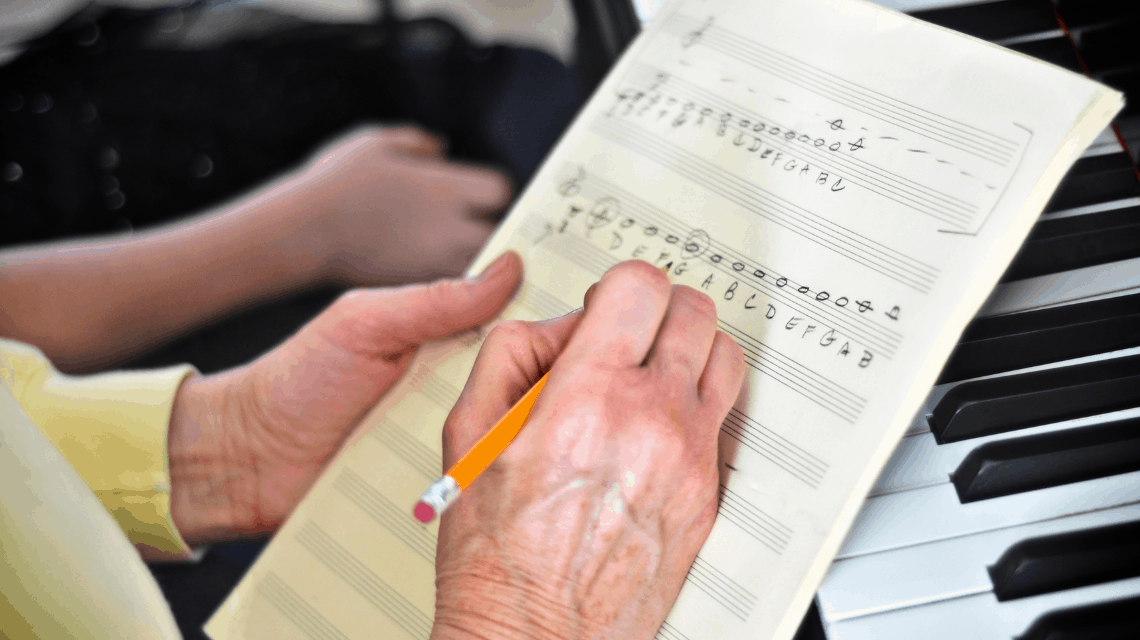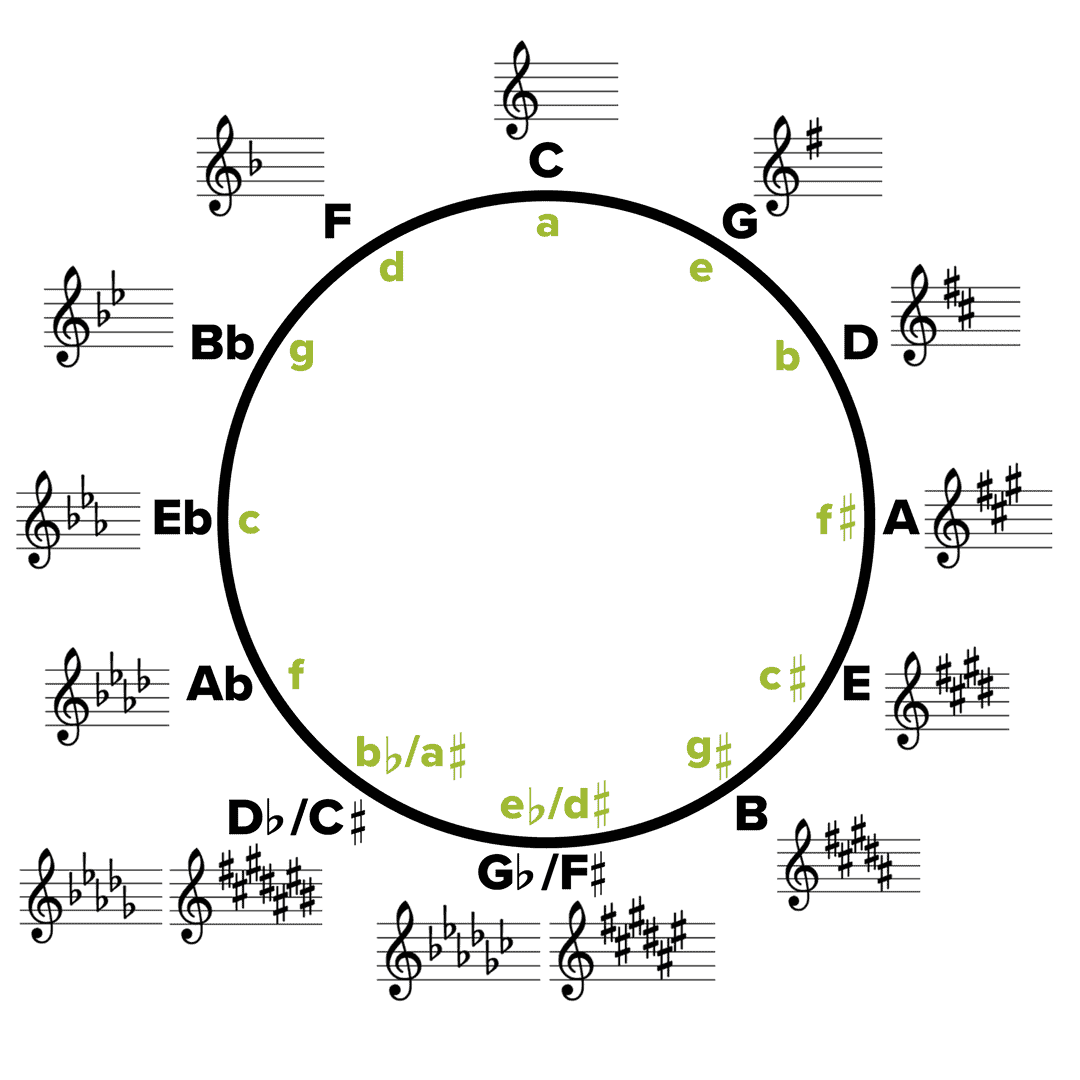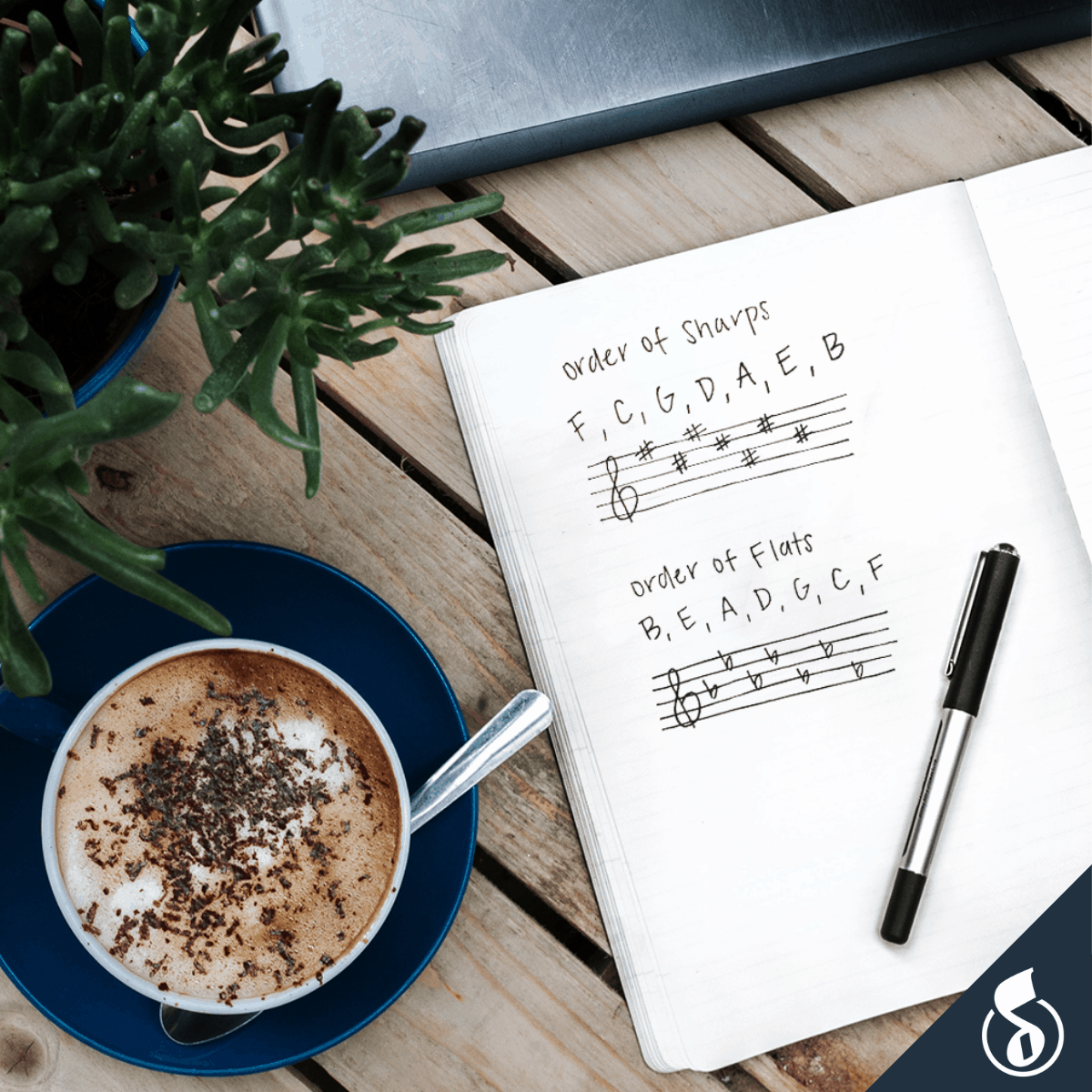5 Ways To Think About Piano Scales and Key Signatures
Read our guide on 5 ways to think about piano scales and key signatures that will help piano students feel less intimidated about the learning process.

A lot of piano students feel intimidated when they see a bunch of sharps or flats in their sheet music.
Many pianists begin by learning to play and read music in the key of C Major, focusing on the geography surrounding the white keys of the piano.
But, once you move beyond the beginning stages of learning the piano, most music is written in other keys that will likely have several sharps or flats to keep track of.
You might relate to that feeling of reading through music with a bunch of sharps and flats and feeling like you’re at odds with the notes on the page. Every black key that rolls along throws you off your reading game and makes your playing feel clumsy and inadequate.
As pianists, it’s important to have a strong understanding of scales and key signatures so that we can learn to play music in any key.
Think about when an artist sits down to paint a picture. They don’t open every single jar of paint that they own and use every color possible.
Instead, they select a handful of colors that work well together and create their masterpiece within the framework of using a certain color scheme.
When we learn scales on the piano, we’re learning which keys or “colors” work well together within the context of a certain key.
For example, when we are playing in G Major, F sharps are a “color” that work better than F naturals.
There are a number of different ways that pianists can think about scales and key signatures in order to keep track of them all. But, it’s most helpful if you have several tricks up your sleeve so you can think about the key of your music from a few different perspectives.
Here are some common ways to learn or remember key signatures.
1. Memorize Piano Scales & Key Signatures
Many musicians have learned the key signatures simply by memorizing them. They may recite something like this until they remember all the possible keys:
C Major, no sharps or flats,
G Major, 1 sharp, F sharp
D Major, 2 sharps, F sharp and C sharp,
Etc.
If you took music theory classes in high school or college, or your childhood piano teacher was big on music theory, then you probably had to name every key signature.
If you’re a person who memorizes things easily or if you just like the challenge of trying to commit a bunch of facts to memory, go for it! Make it your goal to memorize all 15 Major and all 15 minor key signatures.
However, memorizing information can only take you so far. If you don’t understand what that information means or how you will use it, then what’s the point?
Also take the time to familiarize yourself with tools and patterns that will help you to figure out key signatures in a pinch. If your memory fails you for a moment, you’ll need to understand the process of how to find the key of a piece of music and know the scale that goes along with it.
2. Circle of Fifths
The circle of fifths is a wonderfully logical tool that all musicians should be familiar with. At first glance, it might seem like a secret code or overly-complicated pie chart.

But, once you start digging into how it works, it makes a lot of sense and will help you think through how to work with any key signature.
There’s a lot to learn about the circle of fifths, which you can read all about in this article: “Circle of Fifths Guide: Why and How Is It Used?”
But, here are the most important takeaways from the circle of fifths:
- You read the circle of fifths by starting at the top of the circle where you see the key of C Major.
- Each Major key signature has a corresponding minor key signature that shares its sharps or flats.
- As you move clockwise around the circle, the new key is a perfect fifth higher than the previous one. (C—>G is a perfect fifth)
- With each new key moving clockwise, you add 1 sharp to the previous keys.
- The sharps appear in a very specific and standardized order. For example, if you have 1 sharp, it will always be F sharp. You will not find music with 1 sharp where that sharp is, for example, G sharp or D sharp. F sharp is always the first sharp.
- As you move counter-clockwise from C, the new key is a perfect fifth lower than the previous key.
- With each new key in this direction, you add one flat. Just like with sharps, the flats always appear in a specific and standardized order.
- At the bottom of the circle of fifths you will see that the sharp keys overlap with the flat keys. This means that in these keys, the notes on the piano are played exactly the same way, but they are notated and named differently to accommodate the correct number of sharps or flats.
3. Learn the order of sharps or flats
We just learned that sharps and flats always appear in a very standardized and specific order. Learning the order that sharps and flats appear is another tool you can add to your music theory toolbox.
The sharps always appear in this order:
F C G D A E B
The flats appear in the same order in reverse:
B E A D G C F

Some people like to use clever sayings to remember these sequences.
One phrase that works well for sharps is:
Father Charles Goes Down And Ends Battle
You can use the same phrase in reverse to help remember flats:
Battle Ends And Down Goes Charles’ Father
4. Think in whole and half steps
Every scale follows the exact same pattern of whole steps and half steps. For major keys, that pattern is:
W-W-H-W-W-W-H
(W=whole steps; H=half steps)

This means that if you start on a C and move up a whole step, you’re on D, another whole step takes you to E. A half step up from E is F, G is a whole step up, then another whole step is A, followed by a whole step to B. One more half step from B takes you back to C.
This is really easy to see in the key of C because it’s all white keys. Between E and F as well as between B and C, there isn’t a black key, so those are half steps.
Start on any other key of the piano, follow this pattern and it will help you find the correct scale.
Say someone asks you to be in the key of A Major, but you can’t quite remember how many sharps are in the key of A. Use this pattern of whole steps and half steps starting on A and you’ll quickly find that there are 3 sharps in the key of A – F sharp, C sharp and G sharp.
5. Look at key signatures
One thing to understand about key signatures and scales is that when you’re working within a certain key, that starting note becomes your tonal center for the whole piece of music, or until a key change.
So, you might notice that when you’re playing in the key of C Major, you often set up both hands starting on a C. Your song probably starts and ends with a C chord. You’ll probably move around to other notes and chords, but you’ll often return to C. C is your home base when you’re playing in the key of C.
Having an awareness of your tonal center while playing in any key is really important.
Instead of looking at music and thinking “I’m playing with five flats right now,” you want to think “This song is in the key of D-flat Major.”
This line of thinking will help you feel oriented to the correct key and it will be much easier to navigate all of the flats from a solid starting point rather than thinking of them as five random black keys that you have to deal with.
If you’re looking at a key signature, here are 2 tricks you can use to determine what scale that that key signature belongs to:
If you’re looking at a sharp key signature, find the final sharp listed, the one on the far right of the key signature. Play that key on the piano and move up a half step. That new key a half step up is the key that corresponds with that key signature.
For example, when there is only one sharp in a key signature, it’s F sharp. A half step up from F sharp is G. So, you’ll be playing in the key of G.
Or, if you see these sharps: F sharp, C sharp, G sharp, D sharp
Find the D sharp and move up a half step. That brings to E, so you’re in the key of E.

For flat keys, it works a little differently.
This time, you’ll want to look at all of the flats and find the one that is the second to last flat listed.
So, if your key signature has: B flat, E flat, A flat, D flat, G flat
The second to last flat listed is D flat. So you’ll be playing in the key of D flat.
This trick doesn’t work if you just have 1 flat – B flat. Obviously, there isn’t a second to last flat if there is only one.
This is a case where having the keys memorized will help you out. Or, you could check in on the circle of fifths and find that it’s the key of F.

We’ve given you a lot of information about scales and key signatures today. Don’t feel overwhelmed if it doesn’t make complete sense.
One of the best parts of studying music is that when you learn something new, you can put it into practice right away.
If you’d like to become more confident playing and reading music in other keys, here’s a good way to practice:
- Learn a scale in a new key. If you haven’t played many scales before, start simple by playing an F scale or a G scale with just one flat or sharp.
- Find a piece of music that matches the scale you just learned. For practice, find something a little below your level so that you can focus on playing well in a new key.
- As you are learning your music in a new key, be thinking in terms of the key as you play. If your song is in the key of F, notice that F is your tonal center as you play. Be mindful of B flats and consider them a unique color that you are using in your music in the place of B naturals.
This last step is vital to learning and understanding scales and key signatures.
The sharps and flats that appear in your music usually aren’t selected at random. You can be completely prepared for them and as you play, you can mentally “be” in the key that you are playing in.
Also, these ideas are just a tiny snapshot of many more ways that you could think about and learn about scales and key signatures. Take what works for you and chances are, you’ll discover even more tools for your music theory toolbox as you learn more about music.
To put your knowledge to the test, check out our piano sheet music collection!
This post was written by Megan, piano teacher and author of Pianissimo: A Very Piano Blog. Visit her website for more piano related blogs for teachers, parents, students, and all things piano.
Shop Related Products:

